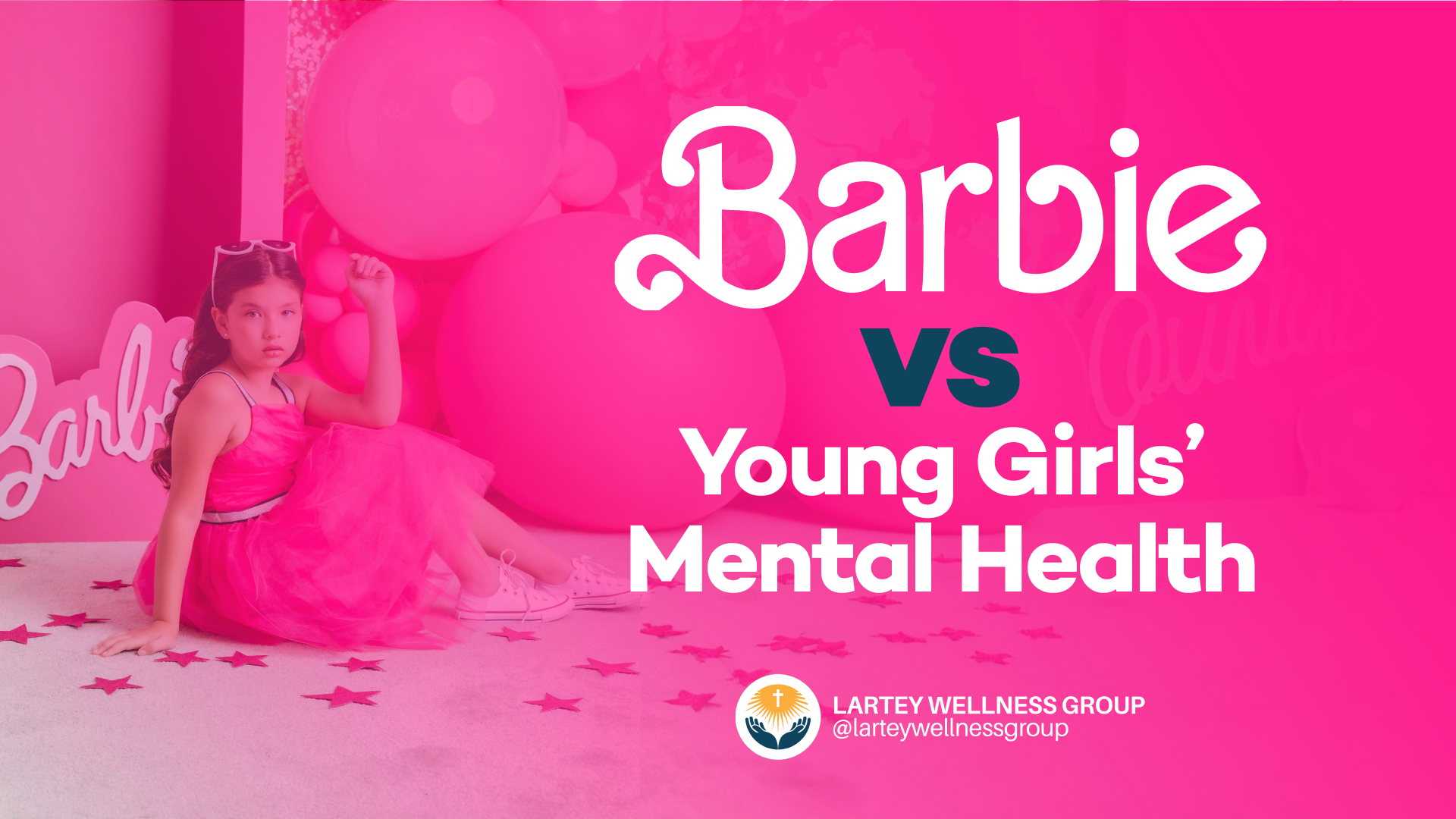Barbie VS Young Girls: The Impact of Barbie on Young Girls' Mental Health.
/Barbie dolls have become a cultural phenomenon, captivating the minds of young girls around the world. However, beneath the glitz and glamour lies a significant influence that can shape the mental well-being of these impressionable individuals. Understanding the potential implications is of utmost importance, as it opens doors for proactive measures to promote healthier attitudes toward body image, self-esteem, and gender roles.
Historical Perspective of Barbie
Barbie, first introduced in 1959, has evolved over the years, capturing the imagination of generations of young girls. From her humble beginnings as a fashion-forward doll, she has become a global icon that represents beauty ideals and fashion trends. However, the question arises: Is Barbie's portrayal of beauty standards an aspirational ideal or a harmful influence on young girls?
Barbie's Influence on Body Image
Research has shown a correlational link between exposure to Barbie dolls and body dissatisfaction among young girls. Barbie's unattainable proportions and perpetuation of unrealistic beauty standards can negatively impact their self-perception. As young minds strive to align themselves with this idealized image, they may fall victim to feelings of inadequacy and even body shaming.
Unrealistic beauty standards perpetuated by Barbie: With her impossibly slim waist, long legs, and perfectly proportioned body, Barbie sets a standard of beauty that is unattainable for the majority. This reinforces the notion that only those who fit within these physical parameters can be considered beautiful.
Exploring the potential for low self-esteem and body shaming: When young girls feel they fall short of Barbie's beauty standards, it can lead to a diminished sense of self-esteem and a tendency to compare themselves to others. This can contribute to body shaming, both internally and amongst peers.
Social and Peer Pressure: The Barbie Syndrome
Barbie's perceived state of perfection can have a profound impact on young girls' self-concept and their desire to conform to societal beauty norms. This pressure extends beyond appearance and permeates their clothing choices, personal style, and even relationships.
The impact of Barbie's perceived perfection on girls' self-concept: When young girls constantly see Barbie as the epitome of perfection, they may develop a skewed self-concept, constantly striving to emulate her flawless image.
Influence of Barbie on clothing, appearance, and relationships: The pressure to conform to a Barbie-like image can lead to girls adopting clothing styles and appearance choices that align with the doll. This can also affect their relationships, as they may feel compelled to seek validation based on appearance rather than personal qualities.
Cognitive and Emotional Development: Barbie's Effect
While playing with Barbie dolls can enhance imaginative play and creativity, it also perpetuates stereotypical gender roles and limits aspirations, potentially hindering cognitive and emotional development.
Role-playing with Barbie and its impact on imagination: Engaging in imaginative play with Barbie can foster creativity and storytelling abilities as girls create scenarios and give life to their dolls.
Stereotypical gender roles perpetuated by Barbie's careers: Barbie's extensive range of careers, while seemingly empowering, often reinforce traditional femininity and limit girls' aspirations. By predominantly representing women in stereotypical female-dominated professions, Barbie may inadvertently discourage girls from pursuing careers traditionally associated with men.
Emotional expression and empathy development through play: Playing with dolls like Barbie can facilitate emotional expression and empathy development, as girls project their emotions onto the dolls and engage in nurturing role-playing activities.
The Role of Barbie in Gender Stereotyping
Barbie's influence on young girls extends beyond individual aspirations, contributing to the perpetuation of gender stereotypes and limited notions of femininity.
Reinforcement of traditional femininity and limited aspirations: Barbie's focus on fashion, beauty, and domestic roles perpetuates stereotypes that associate femininity with limited aspirations. This reinforcement can hinder girls' exploration of diverse interests and may limit their belief in their own capabilities.
Gender representation and diversity within the Barbie line:* While Barbie has made strides towards inclusivity and diversity by introducing dolls of different ethnicities and body types, a closer examination reveals a lack of representation for boys and limited portrayal of non-binary individuals, thus reinforcing gender binaries.
Parental Influence and Barbie
Parents play a pivotal role in a child's relationship with Barbie, shaping their attitudes towards body image, self-esteem, and gender roles.
The role of parental expectations in the Barbie phenomenon: Parents' beliefs and attitudes towards Barbie can significantly impact how a child perceives the doll and herself. Parents who prioritize appearance and adhere to societal beauty standards may unintentionally send messages that reinforce unattainable ideals.
Influence of parental attitudes on body image and self-esteem: Positive body image and self-esteem are nurtured when parents encourage a healthy appreciation of diverse appearances and emphasize inner qualities rather than physical attractiveness. Conversely, parents' negative body image perceptions may contribute to their child's dissatisfaction with her own body.
Balancing parental guidance with a child's autonomy and choice: While parents hold significant influence, it is crucial to strike a balance between guidance and allowing children to exercise their independence and make informed choices regarding their toys and play preferences.
Social and Cultural Factors: Barbie's Reception
Barbie's reception varies across societies and cultures, influenced by societal perceptions and cultural norms. Understanding these differences provides insights into the diverse impact of Barbie on young girls' mental health.
Societal perceptions and cultural norms surrounding Barbie: Societal context plays a vital role in shaping how Barbie's influence is perceived and experienced. Cultural norms related to beauty, femininity, and gender roles differ, affecting the degree to which Barbie's presence is regarded as aspirational or detrimental.
Cross-cultural differences in the impact of Barbie on mental health: Research indicates that the potential negative impact of Barbie on mental health may be more pronounced in cultures with stronger emphasis on appearance and rigid gender expectations. Conversely, in cultures that prioritize other qualities and diverse representations, girls may be less affected by Barbie's influence.
Critical analysis of advertising and media campaigns: Barbie's presence in advertising and media campaigns can exacerbate the impact on mental well-being. The messages conveyed through these mediums greatly influence young girls' aspirations and perceptions of themselves.
The Role of Education and Schools
Schools and educational institutions bear a responsibility in addressing the impact of Barbie dolls. By promoting critical thinking and media literacy, educators can empower young girls to challenge societal beauty standards and develop a more inclusive mindset.
Exploring the impact of Barbie on girls' performance in school: It is essential to investigate any potential correlation between Barbie dolls and academic performance. While playing with Barbie can enhance creativity and imaginative skills, it is crucial to ensure that its influence does not hinder girls' educational development.
Encouraging critical thinking and media literacy in schools: Including topics related to body image, self-esteem, and gender stereotypes in the curriculum allows educators to facilitate critical analysis and empower students to question societal norms perpetuated by dolls like Barbie.
Addressing Barbie's influence through inclusive education initiatives: Creating an inclusive educational environment that fosters acceptance and celebrates diversity can help counteract the influence of dolls like Barbie and promote a more holistic understanding of self-worth and individuality.
Empowering Alternatives to Barbie
While Barbie has made efforts to diversify its doll line, it is essential to introduce alternative dolls that promote diversity, inclusivity, and positive role models to inspire young girls' mental well-being.
Introducing diverse and inclusive doll alternatives: By offering diverse representations of ethnicity, body types, and abilities, alternative dolls can provide a counter-narrative to Barbie's limited standard of beauty and traditional gender roles, fostering self-acceptance and empowerment.
Positive role models and their impact on mental well-being: Dolls that celebrate real-life accomplished women, representing diverse fields and achievements, can broaden young girls' aspirations and help build resilience against the narrow standards Barbie perpetuates.
The importance of nurturing self-acceptance and self-expression: Dolls that encourage individuality, self-expression, and the celebration of unique physical appearances can foster self-acceptance and contribute to a healthier sense of identity.
The Responsibility of Toy Manufacturers and Marketers
Toy manufacturers and marketers have a crucial role to play in shaping young girls' mental well-being. Ethical considerations, accountability, and promoting body positivity should guide their practices.
Ethical considerations in the production and marketing of dolls: Toy manufacturers must acknowledge the impact their products have on children's mental health and prioritize responsible practices. This includes avoiding harmful stereotypes, promoting diverse representation, and ensuring dolls are inclusive of various identities and abilities.
Encouraging accountability and promoting body positivity: By actively working to counteract unrealistic beauty standards and implementing body-positive strategies in marketing campaigns, toy manufacturers can contribute to a more positive mental health environment for young girls.
The potential for positive social change through responsible practices: When toy manufacturers and marketers embrace their social responsibility, they not only contribute to the well-being of young girls but also inspire positive changes in wider societal perceptions of beauty and acceptance.
Parenting Strategies: Cultivating Healthy Perspectives
Parents can play a proactive role in cultivating healthy perspectives when it comes to Barbie's influence on their children. Open communication, critical thinking, and challenging beauty standards are key elements in promoting a positive mindset.
Open communication and fostering body positivity discussions: Encouraging open dialogue with their children about body image, beauty standards, and media influence helps parents understand the impact of Barbie dolls and guide their children towards healthier perspectives.
Encouraging critical thinking and challenging beauty standards: Parents can empower their children by teaching critical thinking skills and encouraging them to question societal beauty norms perpetuated by Barbie. By promoting individuality and self-acceptance, they can help children develop a stronger sense of self-worth beyond appearance.
Balancing the importance of play and promoting well-roundedness: While it is essential to address the influence of dolls like Barbie, parents should also prioritize the importance of play in childhood development. Encouraging a diverse range of activities and interests promotes well-roundedness and helps children develop strengths beyond appearances and gender stereotypes.
Barbie's Evolution: Progress or Superficial Change?
Barbie's attempts at diversifying her doll line and representing a broader range of individuals raise questions about the effectiveness of these initiatives. A critical analysis helps determine whether these changes truly impact young girls' mental well-being or if they are merely superficial.
Analyzing Barbie's attempts at diversity and inclusivity: While Barbie's evolution to include dolls with different body types, ethnicities, and abilities is a step in the right direction, it is crucial to explore the extent to which these changes challenge established beauty norms and gender stereotypes.
Evaluating the impact of Barbie's evolution on mental health: Research should investigate whether the inclusion of diverse dolls has resulted in improved mental health outcomes for young girls. This evaluation can shed light on the effectiveness of these initiatives in promoting body positivity and self-acceptance.
Critiquing the effectiveness of Barbie's social responsibility initiatives: Assessing Barbie's broader social responsibility initiatives, such as collaborations and campaigns that advocate for body positivity and inclusivity, can ascertain if these initiatives are mere marketing strategies or efforts to effect positive change.
Barbie's Influence Beyond Childhood
Barbie's influence often extends beyond childhood, seeping into the adolescent and adult years. Unraveling the implications on body image, relationships, and the shifting perspective among these age groups aids in understanding the broader impact of Barbie on mental well-being.
The lingering effects of Barbie on adolescent development: As young girls transition into adolescence, the influence of Barbie may still linger and shape their perspectives on body image, femininity, and self-worth. Exploring how these influences manifest during this developmental stage can illuminate potential areas of concern.
Unraveling the implications on body image and relationships: Barbie's influence can affect body image concerns and relationship patterns in adolescence. The idealized beauty standards portrayed by Barbie may contribute to feelings of dissatisfaction, insecurity, and unhealthy relationship dynamics.
Exploring adult perspectives on the Barbie phenomenon: Understanding how Barbie's impact carries into adulthood provides valuable insights into society's long-term perception of beauty and gender norms. Adult perspectives on Barbie can inform debates about societal standards and the potential for change.
Mental Health Interventions: Addressing Barbie's Impact
Mental health professionals play a crucial role in addressing the negative effects of Barbie on young girls' mental well-being. Through therapeutic approaches and collaborations with parents, educators, and media, interventions can pave the way for a healthier relationship between young girls and dolls in the future.
Therapeutic approaches to mitigating the negative effects: Mental health professionals can employ evidence-based interventions that focus on promoting self-esteem, body positivity, and critical thinking skills to counteract the negative effects of Barbie on young girls' mental health.
Promoting self-esteem and body positivity in clinical settings: Therapeutic interventions can provide a safe space for young girls to explore their self-worth, challenge beauty standards, and foster body positivity. Activities that emphasize personal strengths and encourage self-acceptance can help build resilience against the harmful impacts of Barbie.
Collaborating with parents, educators, and media to effect change: By collaborating with parents, educators, and media influencers, mental health professionals can promote awareness, deliver educational programs, and encourage proactive approaches to address the impact of Barbie on young girls' mental well-being.
Public Perception and Media Debates
Public perception and media debates surrounding Barbie's influence are of utmost importance when advocating for change. Analyzing media portrayals, controversies, and engaging in evidence-based discussions can help shape a more informed and responsible approach to the discourse.
Analyzing media portrayals and public discourse on Barbie: Media plays a significant role in perpetuating or challenging beauty standards; analyzing the representation of Barbie in various media can shed light on the messages conveyed and their impact on mental health.
Controversies surrounding Barbie's influence on mental health: Public debates surrounding Barbie's influence can provide platforms for discussions on mental health, body image, self-esteem, and gender roles. Examining these controversies helps identify key areas of concern that need to be addressed.
The importance of evidence-based discussions on this issue: Engaging in evidence-based discussions, supported by research, is crucial in navigating the complexities of Barbie's impact on mental well-being. These discussions contribute to a deeper understanding of the issue and inform potential solutions.
Policy and Legislative Measures
To create systematic change, policy and legislative measures that address responsible toy manufacturing, inclusivity, and realistic portrayal in dolls must be prioritized.
Regulations and guidelines for responsible toy manufacturing: Governments and regulatory bodies should consider implementing guidelines and regulations that ensure dolls, such as Barbie, are ethically produced and marketed, promoting positive mental health outcomes for young girls.










